Dell 0GYVXHA00, 1747, 1745, 1749, GYVXH User Manual
...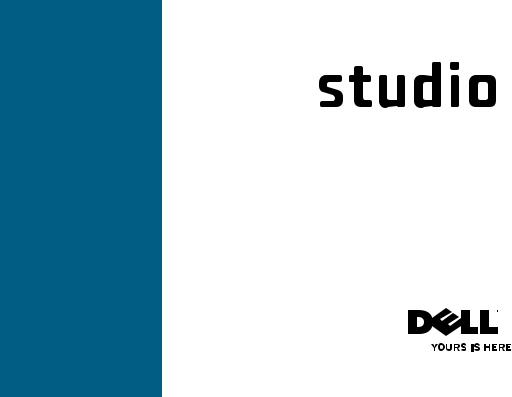
SETUP GUIDE


SETUP GUIDE
Regulatory model: P02E series Regulatory type: P02E001; P02E002

Notes, Cautions, and Warnings
 NOTE: A NOTE indicates important information that helps you make better use of your computer.
NOTE: A NOTE indicates important information that helps you make better use of your computer.
CAUTION: A CAUTION indicates either potential damage to hardware or loss of data and tells you how to avoid the problem.
 WARNING: A WARNING indicates a potential for property damage, personal injury, or death.
WARNING: A WARNING indicates a potential for property damage, personal injury, or death.
__________________
Information in this document is subject to change without notice. © 2010 Dell Inc. All rights reserved.
Reproduction of these materials in any manner whatsoever without the written permission of Dell Inc. is strictly forbidden.
Trademarks used in this text: Dell, the DELL logo, YOURS IS HERE, Solution Station, and DellConnect are trademarks of Dell Inc.; Intel, Pentium, and Celeron are registered trademarks and Core is a trademark of Intel Corporation in the U.S. and other countries; Microsoft, Windows, Windows Vista, and the Windows Vista start button logo are either trademarks or registered trademarks of Microsoft Corporation in the United States and/or other countries; Blu-ray Disc is a trademark of the Blu-ray Disc Association; Bluetooth is a registered trademark owned by Bluetooth SIG, Inc. and is used by Dell under license.
Other trademarks and trade names may be used in this document to refer to either the entities claiming the marks and names or their products. Dell Inc. disclaims any proprietary interest in trademarks and trade names other than its own.
March 2010 P/N GYVXH Rev. A00
Contents
Setting Up Your Studio Laptop 5
Before Setting Up Your Computer |
5 |
Connect the AC Adapter |
6 |
Connect the Network Cable (Optional) |
7 |
Press the Power Button |
8 |
Set Up Microsoft Windows |
9 |
Create System Recovery Media |
|
(Recommended) |
10 |
Install the SIM Card (Optional) |
12 |
Enable or Disable Wireless (Optional) |
14 |
Connect to the Internet (Optional) |
16 |
Using Your Studio Laptop 20
Right Side Features 20 Left Side Features 24 Computer Base and Keyboard Features 28 Touch Pad Gestures 30
Multimedia Controls 32 Display Features 34 Using the Touch Screen (Optional) 36 Removing and Replacing the Battery 40 Software Features 42 Dell DataSafe Online Backup 43 Dell Dock 44 Free Fall Sensor 45
Solving Problems 46
Touch Screen Problems 46 Touch Screen Calibration 47 Beep Codes 48 Network Problems 49 Power Problems 50 Memory Problems 52 Lockups and Software Problems 52
3
Contents
Using Support Tools 55
Dell Support Center 55 My Dell Downloads 56 System Messages 56 Hardware Troubleshooter 58 Dell Diagnostics 59
Restoring Your Operating System 63
System Restore 64 Dell DataSafe Local Backup 65 System Recovery Media 67 Dell Factory Image Restore 68
Getting Help 71
Technical Support and Customer
Service 72 DellConnect 72 Online Services 73 Automated Order-Status Service 74 Product Information 74
4
Returning Items for Repair Under
Warranty or for Credit 75 Before You Call 76 Contacting Dell 77
Finding More Information and
Resources 78 Specifications 80 Appendix 93
Macrovision Product Notice 93
Information for NOM, or Official Mexican Standard (Only for Mexico) 94
Index 95

Setting Up Your Studio Laptop
This section provides information about setting up your Studio 1745/1747/1749 laptop.
Before Setting Up Your Computer
When positioning your computer, ensure that you allow easy access to a power source, adequate ventilation, and a level surface to place your computer.
Restricting airflow around your laptop may cause it to overheat. To prevent overheating ensure that you leave at least 10.2 cm (4 inches) at the back of the computer and a minimum of 5.1 cm (2 inches) on all other sides. You should never place your computer in an enclosed space, such as a cabinet or drawer when it is powered on.
WARNING: Do not block, push objects into, or allow dust to accumulate in the air vents. Do not place your Dell™
computer in a low-airflow environment, such as a closed briefcase, or on fabric surfaces, such as carpets or rugs, while it is powered on. Restricting the airflow can damage the computer, deteriorate the computer performance, or cause a fire. The computer turns on the fan when the
computer gets hot. Fan noise is normal and does not indicate a problem with the fan or the computer.
CAUTION: Placing or stacking heavy or sharp objects on the computer may result in permanent damage to the computer.
5
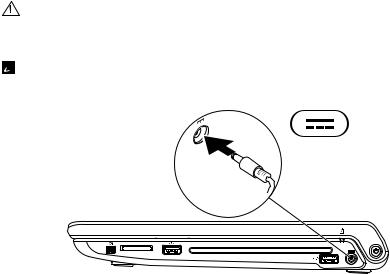
Setting Up Your Studio Laptop
Connect the AC Adapter
Connect the AC adapter to the computer and then plug it into a wall outlet or surge protector.
WARNING: The AC adapter works with electrical outlets worldwide. However, power
connectors and power strips vary among countries. Using an incompatible cable or improperly connecting the cable to a power strip or electrical outlet may cause fire or permanent damage to your computer.
 NOTE: Connect the power cord to the adapter firmly and ensure that the light on the adapter is on when you turn on power.
NOTE: Connect the power cord to the adapter firmly and ensure that the light on the adapter is on when you turn on power.
6
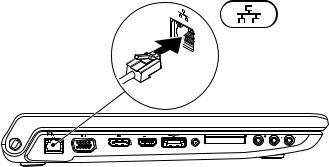
Setting Up Your Studio Laptop
Connect the Network Cable (Optional)
To use a wired network connection, connect the network cable.
7

Setting Up Your Studio Laptop
Press the Power Button
8

Setting Up Your Studio Laptop
Set Up Microsoft Windows
Your Dell computer is preconfigured with the Microsoft® Windows® operating system. To set up Microsoft Windows for the first time, follow the instructions on the screen. These steps are
mandatory and may take some time to complete. The Windows setup screens will take you through several procedures including accepting license agreements, setting preferences, and setting up an Internet connection.
CAUTION: Do not interrupt the operating system’s setup process. Doing so may render your computer unusable and you will need to reinstall the operating system.
 NOTE: For optimal performance of your computer, it is recommended that you download and install the latest BIOS and drivers for your computer available at support.dell.com.
NOTE: For optimal performance of your computer, it is recommended that you download and install the latest BIOS and drivers for your computer available at support.dell.com.
 NOTE: For more information on the operating system and features, see support.dell.com/MyNewDell.
NOTE: For more information on the operating system and features, see support.dell.com/MyNewDell.
9

Setting Up Your Studio Laptop
Create System Recovery Media (Recommended)
 NOTE: It is recommended that you create a system recovery media as soon as you set up Microsoft Windows.
NOTE: It is recommended that you create a system recovery media as soon as you set up Microsoft Windows.
The system recovery media can be used to restore your computer to the operating state it was in when you purchased the computer, while preserving data files (without the need of the Operating System disc). You can use the system recovery media if changes to the hardware, software, drivers, or other system settings have left the computer in an undesirable operating state.
You will require the following to create the system recovery media:
•Dell DataSafe Local Backup
•USB key with a minimum capacity of 8 GB or DVD-R/DVD+R/Blu-ray Disc™
 NOTE: Dell DataSafe Local Backup does not support rewritable discs.
NOTE: Dell DataSafe Local Backup does not support rewritable discs.
10

Setting Up Your Studio Laptop
To create a system recovery media:
1.Ensure that the AC adapter is connected (see “Connect the AC Adapter” on page 6).
2.Insert the disc or USB key in the computer.
3.Click Start  → Programs→ Dell DataSafe Local Backup.
→ Programs→ Dell DataSafe Local Backup.
4.Click Create Recovery Media.
5.Follow the instructions on the screen.
 NOTE: For information on using the system recovery media, see “System Recovery Media” on page 67.
NOTE: For information on using the system recovery media, see “System Recovery Media” on page 67.
11

Setting Up Your Studio Laptop
Install the SIM Card (Optional)
 NOTE: Installing a SIM card is not required if you are using an EVDO card to access the Internet.
NOTE: Installing a SIM card is not required if you are using an EVDO card to access the Internet.
Installing a Subscriber Identity Module (SIM) card on your computer allows you to connect to the Internet. To access the Internet you must be within the network of your cellular service provider.
To install the SIM card:
1.Turn off your computer.
2.Remove the battery (see “Removing and Replacing the Battery” on page 40).
3.In the battery bay, slide the SIM card into the SIM card slot.
4.Replace the battery (see “Removing and Replacing the Battery” on page 40).
5.Turn on your computer.
To remove the SIM card, press and eject the SIM card.
12
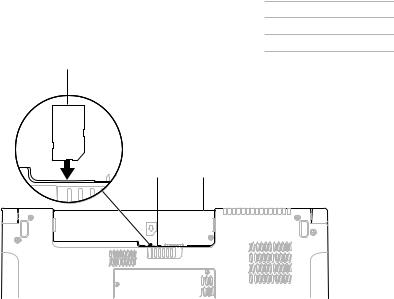
Setting Up Your Studio Laptop
1 SIM card
2 SIM card slot
3 battery bay
1
2 3
13
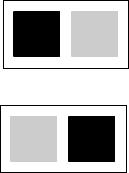
Setting Up Your Studio Laptop
Enable or Disable Wireless (Optional)
Press the 
 key or press the <Fn><F2> keys on the keyboard to enable or disable wireless. The wireless on or off icons appear on the screen to indicate the status.
key or press the <Fn><F2> keys on the keyboard to enable or disable wireless. The wireless on or off icons appear on the screen to indicate the status.
Wireless on:
Wireless off:
For information on changing the behavior of the Fn key, see “Multimedia Controls” on page 32.
14
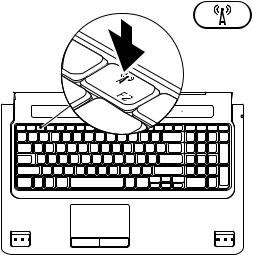
Setting Up Your Studio Laptop
15
Setting Up Your Studio Laptop
Connect to the Internet
(Optional)
To connect to the Internet, you need an external modem or network connection and an Internet Service Provider (ISP).
If an external USB modem or WLAN adapter is not a part of your original order, you can purchase one at www.dell.com.
16
Setting Up a Wired Connection
•If you are using a dial-up connection, connect the telephone line to the optional external USB modem and to the telephone wall connector before you set up your Internet connection.
•If you are using a DSL or cable/satellite modem connection, contact your ISP or cellular telephone service for setup instructions.
To complete setting up your wired Internet connection, follow the instructions in “Setting Up Your Internet Connection” on page 18.

Setting Up a Wireless Connection
 NOTE: To set up your wireless router, see the documentation that shipped with your router.
NOTE: To set up your wireless router, see the documentation that shipped with your router.
Before you can use your wireless Internet connection, you need to connect to your wireless router.
To setup your connection to a wireless router:
Windows® 7
1.Ensure that wireless is enabled on your computer (see “Enable or Disable Wireless” on page 14).
2.Save and close any open files, and exit any open programs.
3.Click Start → Control Panel.
→ Control Panel.
4.In the search box, type network, and then click Network and Sharing Center→ Connect to a network.
5.Follow the instructions on the screen to complete the setup.
Setting Up Your Studio Laptop
Windows Vista®
1.Ensure that wireless is enabled on your computer (see “Enable or Disable Wireless” on page 14).
2.Save and close any open files, and exit any open programs.
3.Click Start  → Connect To.
→ Connect To.
4.Follow the instructions on the screen to complete the setup.
17

Setting Up Your Studio Laptop
Setting Up Your Internet Connection
ISPs and ISP offerings vary by country. Contact your ISP for offerings available in your country.
If you cannot connect to the Internet but have successfully connected in the past, the Internet Service Provider (ISP) might have a service outage. Contact your ISP to check the service status, or try connecting again later.
Have your ISP information ready. If you do not have an ISP, the Connect to the Internet wizard can help you get one.
18
To set up your Internet connection:
Windows 7
1.Save and close any open files, and exit any open programs.
2.Click Start  → Control Panel.
→ Control Panel.
3.In the search box, type network, and then click Network and Sharing Center→ Set up a new connection or network→ Connect to the Internet.
The Connect to the Internet window appears.
 NOTE: If you do not know which type of connection to select, click Help me choose or contact your ISP.
NOTE: If you do not know which type of connection to select, click Help me choose or contact your ISP.
4.Follow the instructions on the screen and use the setup information provided by your ISP to complete the setup.

Setting Up Your Studio Laptop
Windows Vista
1.Save and close any open files, and exit any open programs.
2.Click Start  → Control Panel.
→ Control Panel.
3.In the search box, type network, and then click Network and Sharing Center→ Set up a connection or network→ Connect to the Internet.
The Connect to the Internet window appears.
 NOTE: If you do not know which type of connection to select, click Help me choose or contact your ISP.
NOTE: If you do not know which type of connection to select, click Help me choose or contact your ISP.
4.Follow the instructions on the screen and use the setup information provided by your ISP to complete the setup.
19
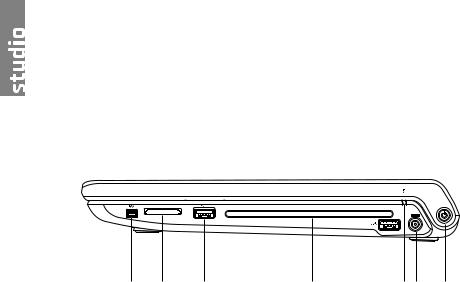
Using Your Studio Laptop
This section provides information about the features available on your Studio 1745/1747/1749 laptop.
Right Side Features
1 |
2 |
3 |
4 |
5 |
6 |
7 |
20

Using Your Studio Laptop
1 IEEE 1394a connector — Connects to high-speed serial multimedia devices, such as digital video cameras.
IEEE 1394a connector — Connects to high-speed serial multimedia devices, such as digital video cameras.
28-in-1 Media Card Reader — Provides a fast and convenient way to view and share digital photos, music, videos, and documents stored on the following digital memory cards:
• Secure Digital (SD) memory card |
• Memory Stick |
• Secure Digital Input/Output (SDIO) card |
• Memory Stick PRO |
• Secure Digital High Capacity (SDHC) |
• MultiMedia Card (MMC) |
• Secure Digital High Density (SDHD) |
• xD-Picture Card |
NOTE: Your computer ships with a plastic blank installed in the media card slot. Blanks protect unused slots from dust and other particles. Save the blank for use when no media card is installed in the slot; blanks from other computers may not fit your computer.
3 USB 2.0 connectors (2) — Connect to USB devices, such as a mouse, keyboard, printer, external drive, or MP3 player.
USB 2.0 connectors (2) — Connect to USB devices, such as a mouse, keyboard, printer, external drive, or MP3 player.
21

Using Your Studio Laptop
4Optical drive — Plays or records CDs, DVDs, and Blu-ray Discs (optional). Ensure that you insert the disc with the printed side facing upwards.
CAUTION: Do not use non-standard size or shape discs (including mini-CDs and mini DVDs) or you will damage the drive.
Place the disc in the center of the disc slot, with the label facing upwards and gently push the disc into the slot. The drive will automatically pull the disc in and begin reading its content.
5 Battery status light — Turns on steadily or blinks to indicate the battery charge status. The light indicates the following states when the computer is powered by
Battery status light — Turns on steadily or blinks to indicate the battery charge status. The light indicates the following states when the computer is powered by
the AC adapter :
•Off — the battery is adequately charged or the computer is turned off.
•Solid white — the battery is charging.
•Solid amber — the battery charge is low and the battery is charging.
the battery :
•Off — the battery is not charging.
•Solid amber — the battery charge is low and you should either plug in the AC adapter or save and close your open documents and applications.
22

Using Your Studio Laptop
6 AC adapter connector — Connects to the AC adapter to power the computer and charge the battery.
AC adapter connector — Connects to the AC adapter to power the computer and charge the battery.
7 Power button and light — Turns the computer on or off when pressed. The light in the button indicates the following power states:
Power button and light — Turns the computer on or off when pressed. The light in the button indicates the following power states:
•Solid white — The computer is on.
•Blinking white — The computer is in standby mode.
•Off — The computer is off or in hibernate state.
23

Using Your Studio Laptop
Left Side Features
|
|
|
|
|
|
|
|
|
|
|
|
|
|
|
|
|
|
|
|
|
|
|
|
|
|
|
|
|
|
|
|
|
|
1 |
2 |
3 |
4 |
5 |
6 |
7 |
8 |
9 |
10 |
|||||||
24

Using Your Studio Laptop
1Security cable slot — Attaches a commercially available security cable to the computer.
NOTE: Before you buy a security cable, ensure that it fits into the security cable slot on your computer.
2 Network connector — Connects your computer to a network or a broadband device if you are using a wired network. The two lights next to the connector indicate the status and activity for a wired network connection.
Network connector — Connects your computer to a network or a broadband device if you are using a wired network. The two lights next to the connector indicate the status and activity for a wired network connection.
3 VGA connector — Connects to video devices, such as a monitor or a projector.
VGA connector — Connects to video devices, such as a monitor or a projector.
4
 DisplayPort connector — Digital interface standard connector that supports external DisplayPort monitors and projectors.
DisplayPort connector — Digital interface standard connector that supports external DisplayPort monitors and projectors.
5 HDMI connector — Connects to a TV for both 5.1 audio and video signals. NOTE: When used with a monitor, only the video signal is read.
HDMI connector — Connects to a TV for both 5.1 audio and video signals. NOTE: When used with a monitor, only the video signal is read.
25

Using Your Studio Laptop
6 eSATA/USB combo connector with USB PowerShare — Connects to eSATA compatible storage devices (such as external hard drives or optical drives) or USB devices (such as a mouse, keyboard, printer, external drive, or MP3 player). The USB PowerShare feature allows you to charge USB devices when the computer is powered on/off or in sleep state.
eSATA/USB combo connector with USB PowerShare — Connects to eSATA compatible storage devices (such as external hard drives or optical drives) or USB devices (such as a mouse, keyboard, printer, external drive, or MP3 player). The USB PowerShare feature allows you to charge USB devices when the computer is powered on/off or in sleep state.
NOTE: Certain USB devices may not charge when the computer is powered off or in sleep state. In such cases, turn on the computer to charge the device.
NOTE: If you turn off your computer while charging a USB device, the device will stop charging. To continue charging, disconnect the USB device and connect it again.
NOTE: The USB PowerShare is automatically shut off when only 10% of the total battery life remains.
7Antenna in connector (on supported models) — Connects to an external antenna to view programs using the TV tuner card (optional).
26

Using Your Studio Laptop
8 ExpressCard slot — Provides support for additional memory, wired and wireless communications, multimedia, and security features. The slot supports 34 mm ExpressCards. NOTE: The ExpressCard slot is designed only for ExpressCards. It does NOT support PC cards.
ExpressCard slot — Provides support for additional memory, wired and wireless communications, multimedia, and security features. The slot supports 34 mm ExpressCards. NOTE: The ExpressCard slot is designed only for ExpressCards. It does NOT support PC cards.
NOTE: Your computer ships with a plastic blank installed in the ExpressCard slot. Blanks protect unused slots from dust and other particles. Save the blank for use when no ExpressCard is installed in the slot; blanks from other computers may not fit your computer.
9 Audio in/Microphone connector — Connects to a microphone or inputs signal for use with audio programs.
Audio in/Microphone connector — Connects to a microphone or inputs signal for use with audio programs.
10 Audio out/Headphone connectors (2) — Connect one or two pairs of headphones, or sends audio to a powered speaker or sound system. The audio signal is the same for both connectors.
Audio out/Headphone connectors (2) — Connect one or two pairs of headphones, or sends audio to a powered speaker or sound system. The audio signal is the same for both connectors.
27
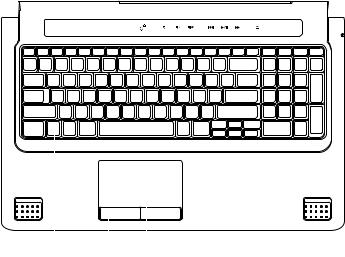
Using Your Studio Laptop
Computer Base and Keyboard Features
|
|
|
|
|
|
|
|
|
|
|
|
|
|
|
|
|
|
|
3 |
||||
1 |
2 |
||||
28
